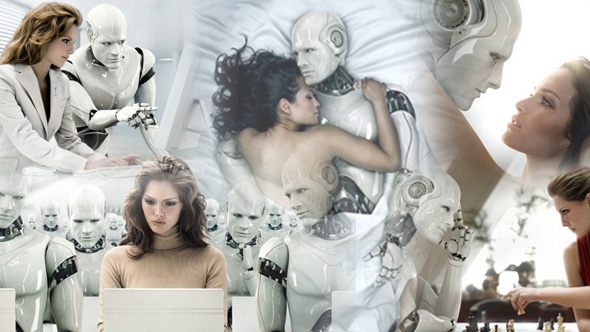 |
| Transhumanity and machines (chilloutpoint.com, 2010) |
The curious scientific mind, akin to the feeling tentacles of the octopus trying to find nourishment or a superior position, is really trying to find the technological nutrients to keep one step ahead of the restless brain extension of itself. We are all but the skin that provides our only feedback (I use skin here as a metaphor for all sense organs) to our scrap full of neuronally entangled brain hell, clamoring to escape, to be extended past our existential limitations. For this to happen, we invent, create, and destroy via those same devises both good and evil (different sides of the same coin).
The two prognostications noted above are also entangled in our progenic yearnings to extend past our death. So, immortality has a newly defined face - technological curiosity (inventions to escape our bodies) and slave surrogates (places to put our new sequence of bodies into). What if we do not engage in this neo-social Darwinist game of flipping physical existences. Instead, what if we redefine our immortality by our perceptual space-times, abandoning physicality all together. What if instead, we deconstruct our information barriers, create artificial information makers, and hence, create anything of any sort, including physical manifestations of alternate universes (generalize many-worlds universes from the same-named interpretation of quantum mechanics to perceptual information universes). Instead, we define death as the never reaching Zeno distance (computed from Zeno machines) Potgieter (2006), between what we are thinking now (which is continuously connected to the next thing we are thinking of anyway - there is no such thing as living in the present-our neuronal structure does not permit that-sorry transcendentalists) and a made up end point of thinking- Western religious definitions of death, (re)incarnations, and transformation. I have just defined a software program for the inscription of digital information immortality. We then embed this as part of the von Neumann self-replicating machine progeny and further mutate it with Godelian self-writing logic to expand itself automatically-defining a superior type of self-reflective and progressive trans-consciousness (von Neumann, 1966; Schmidhuber, 2006). Will machines accomplish this before humans will for them and us? That is the more relevant and fundamental prognostication for human-machine transmogrification.
References
Arbesu, J. (2012). Transport and transhumans. Futurist, 46, 5.
Blasband, M. (2012). When the machines take over. Futurist, 46,5.
chilloutput.com (2010). Retrieved from http://www.chilloutpoint.com/featured/human-and-robots-visions-of-the-future.html.
Potgieter, P. H. (2006). Zeno machines and hypercomputation.arXiv:cs/0412022v3 [cs.CC].
Schmidhuber, J. (2006). Godel machines: Self-referential universal problem solvers making provably optimal self-improvements. arXiv:cs/0309048v5 [cs.LO].
von Neumann, J. (1966). Burks, A. W. (ed.). Theory of self-reproducing automata. Champaign, IL: University of Illinois Press.
No comments:
Post a Comment